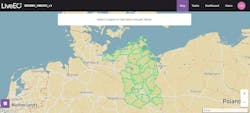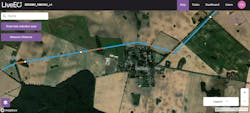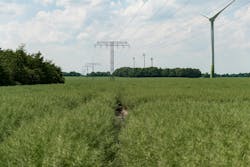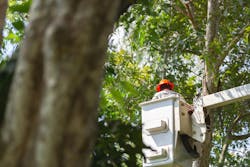Transforming Corridor Management with Satellite Analytics
The global energy landscape is undergoing a significant transformation, spurred by several key trends driving an unprecedented surge in electricity demand worldwide. One major trend is the electrification of various sectors, including transportation and heating, where the rapid adoption of electric vehicles (EVs) and electric heating systems are driving up electricity consumption. Additionally, the proliferation of digital technologies and the Internet of Things (IoT) is increasing the reliance on electronic devices, further propelling the demand for electricity. Moreover, the ongoing industrialization and urbanization in developing economies are fostering a growing need for electricity to power factories, infrastructure and urban amenities.
For electric transmission and distribution companies, these trends pose both challenges and opportunities. On one hand, the increasing demand for electricity necessitates significant investments in upgrading and expanding infrastructure to accommodate higher loads and ensure reliable supply. On the other hand, it opens avenues for innovation and modernization, such as the deployment of smart grid technologies and renewable energy integration. Electric utilities must navigate regulatory frameworks, manage operational complexities and strike a balance between traditional and renewable energy sources to meet the evolving demands of consumers.
The implications of the rising demand for electricity on grid reliability and resilience are profound. Aging infrastructure, coupled with the need for more robust systems to handle increased loads, presents a formidable challenge. Extreme weather events brought about by climate change further underscore the importance of fortifying grid infrastructure against disruptions. Ensuring the stability of the grid is paramount to prevent outages that could have far-reaching economic and societal impacts.
Managing Corridors
In light of these challenges, corridor management has become increasingly critical. These corridors, which host vital infrastructure such as power lines and substations, demand vigilant attention to risks to prevent potential hazards and disruptions. In particular, vegetation risks, such as overgrown trees and vegetation encroachment, pose a significant threat to the reliability of transmission and distribution lines. Overhanging branches or fallen trees can cause outages, fires and other safety hazards. Hence, effective corridor management, which involves regular vegetation monitoring, pruning and removal to maintain safe distances between power lines and vegetation within the Rights-of-Way (ROW), is essential to mitigate these risks and ensure the reliability and resilience of the grid.
E.ON, a European utility company, confronts these challenges with technology and digitalization. Its networks are not only evolving into intelligent systems but so too are its internal processes, including the monitoring and management of vegetation along its utility corridors.
Challenges with the Conventional Approach
As one of Europe’s operators of energy networks and infrastructure, E.ON is catering to about 48 million customers with innovative energy solutions. Spanning across three regional markets—Germany, Sweden, and East-Central Europe/Turkey —E.ON operates an expansive power network. In Germany alone, its nine regional companies oversee about 800,000 km of electricity and gas grids, primarily comprising distribution lines. Managing vegetation risks along such extensive corridors poses a multitude of challenges.
Traditionally, like many electric utilities, E.ON delegates this task to service providers or subcontractors. These subcontractors typically operate under five-year contracts, assuming complete responsibility for keeping the routes clear. Under the conventional approach, the subcontractors would manually inspect the entire route before submitting the offer, and subsequent planning was based on the results of these inspections. Throughout the term of the contract, the subcontractors would perform further manual inspections on a regular basis and adjust their plans accordingly based on risks identified. They would then carry out pruning twice a year, with E.ON conducting quality assurance (QA) using random samples on site. The entire process would take place partly analogously (e.g., planning and creating route plans) or only via Excel or email.
However, this approach posed significant limitations. E.ON’s Distribution System Operators (DSOs) lacked comprehensive visibility over the state of vegetation along the networks as well as the existing risks, as information remained confined within the subcontractors. The QA process was complex, relying on conducting a few random samples, leading to quality deficiencies surfacing only when things became critical. Moreover, reliance on analog and disjointed digital tools made planning, resource allocation and reporting cumbersome and inefficient. Given the vast expanse of the network, not all risks were invariably identified, resulting in power disruptions caused by vegetation coming into contact with power lines.
At this point, the company realized that the traditional manual approach just wouldn’t cut it anymore. It recognized the pressing need for a more efficient and intelligent way of managing the vegetation risks around its infrastructure.
Shifting to Intelligent Corridor Management
E.ON is a traditionally innovation-friendly company. For some time, it has been exploring new technologies such as augmented reality and IoT, as well as drones for inspecting power lines. Thus, embracing the rapidly advancing satellite technology was a natural progression for the company.
E.ON’s foray into space-based technologies started in 2020 when it partnered with LiveEO for a pilot project involving its subsidiary E.DIS, followed by another successful pilot with Bayernwerk in 2021. Encouraged by the positive outcomes of these initiatives, E.ON made the strategic decision to make LiveEO’s Treeline the standard solution for satellite-based vegetation management starting in 2023.
The comprehensive rollout involves monitoring more than 80,000 km of medium-voltage and high-voltage overhead lines in Germany, with potential expansion into Hungary. The overarching objective is two-fold: to enhance vegetation risk management along power line corridors, and to improve internal operations, subcontractor collaboration and stakeholder management.LiveEO employs satellite imagery with a horizontal resolution of 3 m and performs 3D vegetation classification on this data within a corridor of at least 80 m wide along the network. Vegetation classification is based on machine learning models trained by LiveEO on local training datasets, where individual trees, dense trees and forests are identified. The location of the vegetation is then combined with a catenary curve model of grid systems to determine horizontal and vertical grow-in encroachment risk and fall-in risk along the ROW. The insights derived are accessible via LiveEO’s web and mobile applications.
E.ON DSOs integrate these insights into its utility vegetation management (UVM) program, covering every stage from pre-planning to execution to close-out:
- Subcontractors receive the analytics prior to submitting their offer, enabling them to accurately estimate the expected effort or scope of work. This allows them to submit a more tailored offer accordingly, facilitating more efficient resource allocation. Once the contract has been awarded, the subcontractors receive the route information via the LiveEO app, replacing the analog method. The use of the LiveEO app, which is mandatoryfor subcontractors, helps ensure the seamless flow of critical insights among relevant stakeholders, thereby streamlining the process.
- Based on the analytics, the annual planning and scheduling of the operations are carried out in the LiveEO app. All pertinent data such as risk classification, risk type, location and even cadastral information are recorded in the tool. This allows risk prioritization, data-driven decision-making and effective stakeholder management.
- After planning, tasks are assigned to the appropriate employees or work teams via the LiveEO app for the actual on-ground execution. Having accurate data on risks, the field crew can do precise treatment and cutting prescriptions, reducing operational costs.
- After pruning, the work carried out is logged in the LiveEO app, enhancing reporting and documentation.
- Following the pruning period, subcontractor work undergoes quality control via the LiveEO app, employing protocols and a before-and-after comparison.
In essence, LiveEO’s Treeline solution serves as a comprehensive platform for mapping and managing the entire vegetation management process of E.ON, enabling the company to effectively address risks across its infrastructure.
Transformative Results
In just a few months since the start of the rollout, E.ON’s adoption of this intelligent approach has yielded the following results:
- Enhanced situational awareness: By gaining comprehensive insights into potential vegetation
encroachment, E.ON can proactively manage grow-in and fall-in threats, enhancing grid resilience and reliability. - Streamlined workflows: Using intuitive apps for planning work packages and dispatching work orders has streamlined operations, optimizing resource allocation and improving efficiency.
- Effective stakeholder management: Access to cadastral information facilitates better management of external stakeholders, including landowners, leading to smoother interactions and negotiations.
- Cost savings: By optimizing operations and reducing downtime due to vegetation damage or contact, E.ON expects to achieve a significant reduction in vegetation management costs.
With these outcomes, E.ON anticipates further improvements in operational efficiency, as well as system reliability, poised to yield a reduction in SAIDI and consequently, elevate customer satisfaction.
E.ON’s adoption of satellite data and AI technology represents a paradigm shift in corridor management, offering insights and efficiencies elevating grid resilience and reliability in the face of growing energy demands and environmental challenges. As the energy sector continues to evolve, such innovative approaches will play a pivotal role in shaping a sustainable and resilient energy future.
About the Author
Sven Mögling
Sven Mögling ([email protected]) was awarded a Master’s Degree in Business Management by the Otto-Guericke University, Magdeburg, Germany in 2005 and then joined Regiocom GmbH as a Team Leader and Project Manager (IT Systems and Customer Management) for Distribution System operator’s energy with a focus on Feed-In Management. In 2015, Mogling moved on to e.kundenservice Netz GmbH (E.ON Group) where his role was an Advisory for Processes and Projects and in 2019 he was appointed as the Innovation Manager with a focus on new technologies for energy networks by E.DIS Netz GmbH (E.ON Group).




